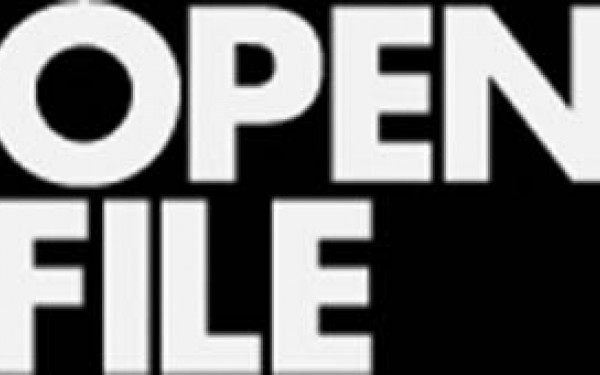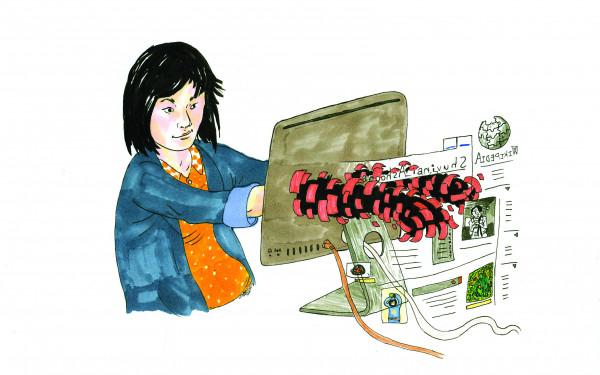Digital Sightseeing
New Media Arts Festival Sight + Sound Interprets the Black Market
Organized by the Eastern Bloc, Montreal’s multimedia exhibition centre, the Sight + Sound festival will exhibit installations and host performances by international digital media artists from around the world, beginning today.
The festival spans three weeks and showcases works that incorporate black market themes.
Artistic director and curator at the Eastern Bloc Eliane Ellbogen describes the black market as made up of structures and systems that function under the radar.
“They function in parallel or in alternative to more apparent socio-political and economic structures,” she said, explaining that the festival is curating works that explore the way these systems function, and the networks they create.
“The idea is to create an overview, or links between these systems and how they relate to contemporary digital culture and telecommunications systems,” she said.
Jean-Baptiste Bayle’s “Terminator Studies” installation is a satirical cartography that demonstrates the connections between the Terminator film series and contemporary political structures.
“There’s some fiction there but there is also a lot reality,” Ellbogen said. “There are obvious links between Arnold being the governor of California and also being the star of the film trilogy.”
Online, the most well-known black market network is the deep web, made up of web content accessible through standard search engines like Google.
According to Ellbogen, over the years, the number of performances and installations directly interacting with the Internet has increased.
One such performance in this year’s programme is Raphael Lyon’s “The Limits of Perception and the Rectangular Frame 2.” Lyon creates a 45-minute narrative through Google’s search bar and, through this interactivity with the Internet, pieces together a story.
French artist Nicolas Maigret presents two pieces at this year’s festival: the projected analysis of peer-to-peer exchanges “The Pirate Cinema” installation and a performance of hard-drive disk-scratching entitled “System Introspection.”
System Introspection —Nicolas Maigret
“The Pirate Cinema,” produced in collaboration with media artists and engineer Brendan Howell, intercepts and presents the underground and obscure file exchanging activity online in a control room setting, with multiple screens displaying parts of files, movies, TV shows, porn, etc. as they are traversing the torrent system.
File sharing is the subject of controversy, specifically with regards to copyright laws. Maigret wanted “to give a form and make it possible to be sensed and felt by people.”
“System Introspection” also explores how data can be translated into raw sound and visuals. The performance is a modern play on vinyl record scratching: Maigret scratches a computer hard-drive and tricks the computer into reading data stored as binary codes, such as Word documents or an iTunes playlist, into sound and pixels.
The project is intended to present computer language, which isn’t meant to be read by humans, in a visually and sonically tangible way—offering audiences the chance to have a critical experience of data.
“Today we are surrounded by data, and a lot of abstract data, we are producing it all the time,” Maigret said, explaining his inspiration.
“Your mobile phone in your pocket is producing data right now, your computer as well—soon your microwave will be producing data.”
“Untitled (Piece for Sound and Light #2),” a performance by Montreal-based artist and musician Steve Bates, explores the links between audio and visuals. Bates will convert live sounds in the Eastern Bloc into a video signal that displays a visual translation of these sounds.
Bates, who holds an MFA from Concordia, created a sensory feedback system that tricks a projector into emitting coloured, black or white light depending on the sound’s frequency or volume.
This interest in manipulating sensory products stems from his work as a musician.
“I also love guitar feedback and noise and use that in other performances as a sound source as well,” Bates said. “If you lean an electric guitar up against a amplifier with the sound at 11 running through effects pedals, I can listen to that happily for a really long time.”
The performance is similar to his previous installation “Feedback for a Black Box,” which was exhibited last year in the FOFA gallery.
The festival is in its fifth year and was extended in order to place more emphasis on conferences, workshops and the installations that contribute to a consistent theme, as well as giving more space to the projects so that festival-goers can fully appreciate them.
“The idea is to present a clear curatorial line that is well-articulated with fewer projects rather than just having a cacophony of projects that aren’t necessarily that clearly related to the theme,” said Ellbogen.
Maigret believes the Eastern Bloc’s dedication to supporting new, intelligent, experimental and boundary-crossing projects is exceptional in the art world.
“Not very often are festivals dedicated to pure, cutting edge or experimental or risky projects,” he said.
For Maigret, many new media projects are often less about artistry and more concerned with “promoting the innovation,” showing the potential of new technology without interpreting or critiquing these new systems.
“It’s a way to put more gasoline into the existing system,” he said.
“The idea is to work with artists whose practice is critical and also engaged with new technologies so that there isn’t just, say, a straightforward spectacular presentation of what digital art can be, what it’s proposing to be,” Ellbogen said.
The Eastern Bloc curates pieces that are critical and interactive so that audiences, as mass media consumers, can be more aware of how these technologies are used.
Sight + Sound / May 8 to May 29 / Eastern Bloc (7240 Clark St.)
For more info, visit the festival website.

_900_599_90.jpeg)
_900_401.png)
_900_549.png)
_720_404_90.jpeg)
_900_532_90.jpg)


_600_375_90_s_c1.jpg)
_600_375_90_s_c1.jpg)
